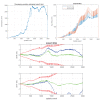Compressed Gaussian Estimation under Low Precision Numerical Representation
- PMID: 37514700
- PMCID: PMC10384378
- DOI: 10.3390/s23146406
Compressed Gaussian Estimation under Low Precision Numerical Representation
Abstract
This paper introduces a novel method for computationally efficient Gaussian estimation of high-dimensional problems such as Simultaneous Localization and Mapping (SLAM) processes and for treating certain Stochastic Partial Differential Equations (SPDEs). The authors have presented the Generalized Compressed Kalman Filter (GCKF) framework to reduce the computational complexity of the filters by partitioning the state vector into local and global and compressing the global state updates. The compressed state update, however, still suffers from high computational costs, making it challenging to implement on embedded processors. We propose a low-precision numerical representation for the global filter, such as 16-bit integer or 32-bit single-precision formats for the global covariance matrix, instead of the expensive double-precision, floating-point representation (64 bits). This truncation can inevitably cause filter instability since the truncated covariance matrix becomes overoptimistic or even turns to be an invalid covariance matrix. We introduce a Minimal Covariance Inflation (MCI) method to make the filter consistent while minimizing the truncation errors. Simulation-based experiments results show significant improvement of the proposed method with a reduction in the processing time with minimal loss of accuracy.
Keywords: CEKF; compressed Kalman filter; compressed estimation; high dimensional estimation; integer precision covariance; low precision numerical format.
Conflict of interest statement
The authors declare no conflict of interest.
Figures
















References
-
- Guivant J.E. The generalized compressed Kalman filter. Robotica. 2017;35:1639–1669. doi: 10.1017/S0263574716000369. - DOI
-
- Narula K., Guivant J.E. Switching and information exchange in compressed estimation of coupled high dimensional processes. Automatica. 2019;99:149–156. doi: 10.1016/j.automatica.2018.10.018. - DOI
-
- Narula K., Guivant J.E., Li X. Non-Linear Estimation with Generalised Compressed Kalman Filter; Proceedings of the 2018 21st International Conference on Information Fusion (FUSION); Cambridge, UK. 10–13 July 2018; pp. 1241–1249.
-
- Guivant J.E., Nebot E.M. Optimization of the simultaneous localization and map-building algorithm for real-time implementation. IEEE Trans. Robot. Autom. 2001;17:242–257. doi: 10.1109/70.938382. - DOI
-
- Guivant J.E., Nebot E.M. Solving computational and memory requirements of feature-based simultaneous localization and mapping algorithms. IEEE Trans. Robot. Autom. 2003;19:749–755. doi: 10.1109/TRA.2003.814500. - DOI
LinkOut - more resources
Full Text Sources

